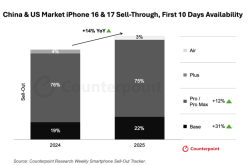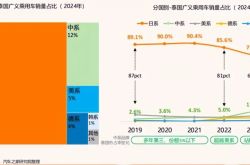Peering Beyond Caocao Mobility's Stock Price: The Future Landscape of Smart Mobility
![]() 07/01 2025
07/01 2025
![]() 853
853

On June 25th, Caocao Mobility rang the listing bell on the Hong Kong Stock Exchange, emerging as the largest technology mobility enterprise in Hong Kong by market capitalization.
Incubated within the Geely Group in 2015, Caocao Mobility has evolved significantly over the past decade. As of December 31, 2024, it operates in 136 cities, recording a total transaction value (GTV) of RMB 16.953 billion for the year, an impressive 38.8% increase from 2023. According to Frost & Sullivan reports, Caocao Mobility has consistently ranked among the top three domestic ride-hailing platforms since 2021, leaping to second place in 2024 based on GTV.
More significantly, Caocao Mobility's technology-driven approach has revolutionized industry data. Its customized vehicle strategy reduces the total cost of ownership (TCO) by 36.4%, enabling drivers to earn up to RMB 35.7 per hour, substantially higher than the industry average of RMB 27. Behind these figures lies a decade of ecological achievements and the key to breaking the ride-hailing industry's vicious cycle, paving the way for healthy development.
Surprisingly, Caocao Mobility's stock price dipped below its issue price on its listing day, prompting a reassessment of the ride-hailing industry. Market sentiment is mixed, with both bearish and bullish outlooks. This reflects investors' and industry observers' concerns about the fierce competition in the ride-hailing market and the need to better understand the differentiated competitive capabilities fostered by technology mobility.
As China's second-largest technology mobility platform, Caocao Mobility has steadily expanded its operating network and customized fleet, leveraging strategic synergies with the Geely Group. It is gradually positioning itself as a leader in the Robotaxi ecosystem.
Zijin Finance believes that Caocao Mobility's development can be divided into two phases, with the Hong Kong listing serving as a pivotal point: transitioning from a traditional ride-hailing platform to a core technology mobility platform in the Robotaxi era. Short-term stock price fluctuations will not undermine its long-term value and competitive edge. Caocao Mobility's efficient, cost-effective, and technologically advanced operational system is poised to achieve fairer value recognition in the capital market.
The Ride-hailing Industry's Impact on People's Livelihoods
After over a decade of growth, China's ride-hailing market has become immense, a vital option for daily travel. Frost & Sullivan data projects that China's mobility market will expand from RMB 8.6 trillion in 2025 to RMB 10.6 trillion in 2029, registering a compound annual growth rate of 5.4%.
As the ride-hailing industry's user base and penetration rate continue to rise, its significance as a people's livelihood industry becomes increasingly apparent. China enforces strict regulations on such industries to ensure people's basic needs are met and to maintain social harmony and stability.
As a people's livelihood industry, ride-hailing boasts a large user base and exhibits rigid demand characteristics. However, in stark contrast to the booming demand, the industry's profitability has long faced an insurmountable ceiling. The transportation authorities' "red line" for commission rates, stipulating that ride-hailing platforms cannot exceed a 30% commission, fundamentally limits platforms' ability to generate excessive profits through high commission rates. Listed platform enterprises also struggle to meet the capital market's high-return expectations by excessively mining "user value".
Apart from commission rate restrictions, platforms must also bear significant pressures in areas such as driver subsidies, daily operating costs, and compliance construction. This explains why many ride-hailing platforms have sustained losses and struggle with profitability. Industry data shows that the average profit margin of ride-hailing platform orders has long hovered below 3%, far lower than other internet service formats.
This "scale expansion and thin profits" industry characteristic makes low driver income and platform profitability persistent challenges. However, from another perspective, while the people's livelihood attribute of ride-hailing limits the industry's high profits, it also creates a unique competitive advantage.
After over a decade of development, the ride-hailing industry is moving away from wild growth, with its characteristics of healthy, stable, and sustainable development becoming increasingly pronounced.
Unlike other optional consumption areas where demand can fluctuate significantly due to economic conditions and changes in consumer preferences, the demand for ride-hailing in rigid scenarios like daily commuting and business travel remains extremely stable. This stability ensures leading ride-hailing platforms enjoy continuous and steady business growth and cash flow.
Caocao Mobility's prospectus clearly highlights this characteristic. In 2024, the company achieved significant revenue growth, with full-year revenue reaching RMB 14.7 billion, representing a 37.4% year-on-year increase. Simultaneously, the company's gross profit margin also improved, rising from 5.8% in 2023 to 8.1% in 2024, indicating continuously optimized profitability.
As the macroeconomy enters a new normal and new productive forces continue to develop, the ride-hailing industry still has ample room for improvement. Controlling costs and enhancing operational efficiency through technological means to achieve a balance between scale and profit remain promising avenues for the industry and the capital market.
Breaking the Profitability Bottleneck with the Customized Vehicle Ecosystem
Caocao Mobility's imagination extends beyond the thriving ride-hailing industry to its differentiated path centered on deeply integrating the supply chain and reconstructing unit economic benefits, leveraging the Geely Group's ecological advantages. This path is embodied in Caocao Mobility's customized vehicle solution, which redefines efficiency through tailored vehicles.
What are the advantages of customized vehicles for ride-hailing platforms? The most evident benefit is a substantial reduction in the total cost of ownership (TCO) of vehicles.
First, Caocao Mobility's customized vehicles are specifically designed for ride-hailing, eschewing private cars' emphasis on luxury and acceleration performance. Instead, all costs are invested in enhancing operational efficiency and passenger experience, leveraging Geely's vehicle manufacturing capabilities. The Maple Leaf 80V and Caocao 60, jointly developed by Caocao Mobility and Geely, enhance durability and maintainability, optimizing seat comfort (like ventilation and lumbar support) to improve the driver experience.
Relying on the Geely ecosystem, Caocao Mobility has also established a comprehensive vehicle service solution encompassing a battery-swapping network and maintenance and repair system, significantly boosting efficiency through standardized operations. As of the end of 2024, Caocao Mobility's customized vehicles are supported by 378 battery-swapping stations in 26 cities. Drivers can complete battery swaps in just 60 seconds upon entering the station, comparable to refueling speeds and saving one hour of energy replenishment time daily.
Additionally, 133 Geely-authorized repair shops provide services for Caocao Mobility's fleet. Through the "Net Repair Plan," Caocao Mobility's maintenance and repair speed is 25% faster year-on-year, with costs reduced by 54% year-on-year. According to Frost & Sullivan data, Caocao Mobility's customized vehicles are expected to have TCOs of RMB 0.53 per kilometer and RMB 0.47 per kilometer, representing reductions of 33% and 40%, respectively, compared to typical electric vehicles.
The effectiveness of customized vehicles is also evident in financial indicators. As the proportion of GTV from customized vehicle orders increased to 25.1% in 2024, the company's gross profit margin climbed from -4.4% in 2022 to 8.1% in 2024, further rising to 8.5% in the first quarter of 2025. The adjusted EBITDA margin improved from -10.1% in 2022 to 2.6% in 2024.
According to the prospectus, as of the end of 2024, Caocao Mobility operated 34,000 customized vehicles in 31 Chinese cities, constituting the largest customized vehicle fleet in China. The proportion of GTV from customized vehicle orders increased from 20.1% in 2023 to 25.1%.
Through the management and control of the entire vehicle lifecycle, Caocao Mobility's various indicators are accelerating, and driver income has also increased, with the average hourly wage rising from RMB 30.9 in 2022 to RMB 35.7 in 2024, surpassing the industry average of RMB 27.
Zijin Finance analysis suggests that as the industry shifts from a "subsidy war" to "efficiency competition," Caocao Mobility's customized vehicles and vehicle service solutions have already brought remarkable efficiency improvements. With further market concentration and easing price wars, combined with Caocao Mobility's scale effect and cost advantage, it is expected to achieve breakeven in the short term.
Robotaxi: Securing an Early Position in the Future Race, Highlighting Long-term Value
If customized vehicles address Caocao Mobility's profitability challenges in the medium to short term, the Robotaxi layout points to the company's growth potential and imagination space for the next decade.
In February 2025, Caocao Mobility's autonomous driving platform—Caocao Zhixing—commenced demonstration operations in Suzhou, Hangzhou, and other locations, becoming one of the few mobility platforms in China to actually implement Robotaxi services.
This layout is underpinned by Caocao Mobility's trinity ecosystem of "customized vehicles + autonomous driving technology + mobility platform," built on the Geely Group, forming a systematic capability. Benchmarking the Tesla Robotaxi model, Caocao Mobility significantly distinguishes itself from Waymo's "division of labor model," which relies on external automakers and platforms.
For Robotaxi players, there are hardly any trinity enterprises in the market, often necessitating partnerships to integrate different capabilities. As a key member of the Geely Group, Caocao Mobility faces fewer barriers to resource integration and can achieve deeper synergies.
Particularly, Caocao Mobility has already demonstrated its TCO control capabilities in the era of human-driven vehicles, such as the 60-second battery-swapping network and a 50% reduction in maintenance costs. Coupled with asset management experience of 34,000 vehicles and a standardized service system, these operational insights can seamlessly transfer to Robotaxi scenarios, significantly lowering Caocao Mobility's Robotaxi commercialization threshold.
Unlike other industry players with vague Robotaxi rollout timelines, Caocao Mobility's Robotaxi strategy has clear expectations for implementation and technical support. The company plans to launch a customized vehicle model specifically designed for L4 autonomous driving by the end of 2026. This model will come pre-installed with autonomous driving components, featuring low TCO and long-duration operation.
Robotaxi's ability to operate for extended periods suggests that the ride-hailing industry's cost structure and profit model are poised for fundamental changes, potentially improving Caocao Mobility's profit margin level.
The market holds high expectations for this prospect. Goldman Sachs predicts that China's Robotaxi market will surge from USD 54 million in 2025 to USD 47 billion in 2035. The strategic synergy between Caocao Mobility and the Geely Group gives it a unique position in the upcoming trillion-level market competition, expected to gain a first-mover advantage in this blue ocean market.
The choice of cornerstone investors underscores industrial capital's recognition of this prospect. Automotive giants like Mercedes-Benz, solid-state battery leader Guoxuan High-Tech, lidar pioneer RoboSense, and battery expert EVE Energy have supported Caocao Mobility with substantial investments, collectively subscribing to approximately HKD 952 million and voluntarily locking up for six months. These strategic bets not only endorse Caocao Mobility but also express confidence in its ability to connect the entire "technology-manufacturing-operation" chain for Robotaxi.
Conclusion
Reflecting on Caocao Mobility's stock price fluctuations in its first week of listing, the underperformance on the first day mainly reflected the market's cautious sentiment towards its short-term profitability. The subsequent rally, however, was a reaffirmation of its long-term value.
In a challenging Hong Kong stock market environment, investors are often more sensitive to growth enterprises' losses while overlooking their significant narrowing. Caocao Mobility's uniqueness lies in its dual-wheel-driven business structure, with the customized vehicle business proving profitable and the Robotaxi business unlocking valuation potential.
True value investing eschews short-term price fluctuations, focusing instead on a company's innovative prowess and irreplaceability amidst dynamic industrial shifts. Serving as a pivotal hub in Geely Group's vision for the future of mobility, Caocao Mobility stands as an indispensable node in the smart car era, playing a strategic role in connecting automobile manufacturing, energy services, and intelligent driving. This synergistic use of intra-group resources endows Caocao Mobility with a natural cost and efficiency edge in the burgeoning trillion-dollar Robotaxi market.
This is merely the dawn of a new narrative. It is anticipated that Caocao Mobility will continue to harness its technological prowess and ecological value in the transition towards smart mobility, evolving into a rare gem characterized by unparalleled efficiency and substantial value potential within the realm of technology-driven mobility.








